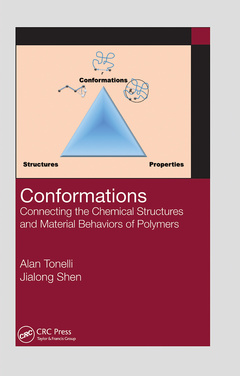Conformations Connecting the Chemical Structures and Material Behaviors of Polymers
Auteurs : Tonelli Alan E., Shen Jialong

Among the materials found in Nature?s many diverse living organisms or produced by human industry, those made from polymers are dominant. In Nature, they are not only dominant, but they are, as well, uniquely necessary to life. Conformations: Connecting the Chemical Structures and Material Behaviors of Polymers explores how the detailed chemical structures of polymers can be characterized, how their microstructural-dependent conformational preferences can be evaluated, and how these conformational preferences can be connected to the behaviors and properties of their materials.
The authors examine the connections between the microstructures of polymers and the rich variety of physical properties they evidence. Detailed polymer architectures, including the molecular bonding and geometries of backbone and side-chain groups, monomer stereo- and regiosequences, comonomer sequences, and branching, are explicitly considered in the analysis of the conformational characteristics of polymers.
This valuable reference provides practicing materials engineers as well as polymer and materials science students a means of understanding the differences in behaviors and properties of materials made from chemically distinct polymers. This knowledge can assist the reader design polymers with chemical structures that lead to their desired material behaviors and properties.
Contents
Preface ...................................................................................................... ix
Authors ...................................................................................................xiii
Chapter 1 Polymer Physics or Why Polymers and Their Materials
Can Behave in Unique Ways ................................................ 1
Introduction .......................................................................... 1
References ............................................................................ 7
Discussion Questions ............................................................ 7
Chapter 2 Polymer Chemistry or the Detailed Microstructures
of Polymers ........................................................................... 9
Polymerization ...................................................................... 9
Step-Growth Polymers ..................................................... 9
Chain-Growth Polymers .................................................11
Chain-Growth Polymer Microstructures ................... 12
Branching and Cross-Linking ....................................14
Comonomer Sequences ...............................................17
References ...........................................................................18
Discussion Questions ...........................................................18
Chapter 3 Determining the Microstructural Dependent
Conformational Preferences of Polymer Chains .................19
Introduction .........................................................................19
References ...........................................................................41
Discussion Questions .......................................................... 42
Appendix: Fortran Program for Hexane “by-hand”
Conformational Populations and Distances ........................43
Chapter 4 Experimental Determination of Polymer
Microstructures with 13C-NMR Spectroscopy ................... 57
Introduction ........................................................................ 57
Substituents Effects ............................................................ 58
References .......................................................................... 67
Discussion Questions .......................................................... 67
Appendix 4.1: Polymer Macrostructures and the
Kerr Effect .......................................................................... 68
Appendix 4.2: Access to Program (FORTRAN) Used
to Calculate Molar Kerr Constants for Polymers ............... 84
Chapter 5 Connecting the Behaviors/Properties of Polymer
Solutions and Liquids to the Microstructural
Dependent Conformational Preferences of Their
Polymer Chains .................................................................109
Introduction .......................................................................109
Intrinsic Viscosities of Dilute Polymer Solutions ..............112
Polymer Entanglement ......................................................115
Dynamic Behaviors of Polymer Solutions and Melts ....... 120
References ........................................................................ 120
Discussion Questions .........................................................121
Chapter 6 Connecting the Behaviors/Properties of Polymer Solids
to the Microstructural Dependent Conformational
Preferences of Their Individual Polymer Chains ..............123
Introduction .......................................................................123
Solid Polymer Properties and Zconf ................................... 124
Copolymer Tgs and Their Comonomer-Sequence
Dependence ...................................................................... 125
Melting Temperatures of Semi-crystalline Polymers ........132
The Flexibilities of Polymers with
1,4-attached Phenyl Rings in Their Backbones ................140
Poly(ethylene phthalates) ...............................................140
Polymers with High Impact Strengths Well
Below Their Glass-Transition Temperatures .................144
Elastic Polymer Networks .................................................149
Thermodynamics of Polymer Networks .......................151
Polymer Network Topology ..........................................152
Modulus of a Polymer Network ....................................167
References .........................................................................174
Discussion Questions .........................................................177
Appendix 6.1 .....................................................................178
Chapter 7 Biopolymer Structures and Behaviors
with Comparisons to Synthetic Polymers ..........................179
Introduction .......................................................................179
Polysaccharides .................................................................179
Proteins ..............................................................................184
Polynucleotides ................................................................. 200
References .........................................................................212
Discussion Questions .........................................................215
Index ......................................................................................................217
Alan Tonelli, born in Chicago in 1942,
received a BS in Chemical Engineering
from the University of Kansas, in 1964 and
a PhD in Polymer Chemistry from Stanford
in 1968, where he was associated with the
late “Father of Polymer Science” and
Nobelist Professor Paul J. Flory. He was a
member of the Polymer Chemistry Research
Department at AT&T-BELL Laboratories,
Murray Hill, NJ for 23 years. In 1991, he
joined the Textile Engineering, Chemistry, & Science Department and the
Fiber & Polymer Science Program in the College of Textiles at North
Carolina State University in Raleigh, where he is currently the
INVISTA Prof. of Fiber & Polymer Chemistry. Professor Tonelli’s research
interests include the conformations, configurations, and structures of synthetic
and biological polymers, their determination by NMR, and establishing
their effects on the physical properties of polymer materials. More
recently, the formation, study, and use of inclusion complexes formed with
polymers and small molecule guests, such as urea and cyclodextrins, to
nanostructure and safely deliver biologically active molecules to polymer
materials have been the focus of his research.
Jialong Shen, born in Hangzhou, China, in
1987, received a PhD in Fiber and Polymer
Science from North Carolina State
University, North Carolina, United States,
in 2017. His research interests include the
molecular basis of polymer glass transitions,
host-guest supramolecular chemistry, and
the applications of bio-macromolecules
such as carbohydrate polymers and enzymes.
He is currently a postdoctoral research
scholar in the Textile Engineering, Chemistry, & Science Department at
North Carolina State University.
Date de parution : 12-2021
15.6x23.4 cm
Date de parution : 04-2020
15.6x23.4 cm
Thèmes de Conformations :
Mots-clés :
RIS Model; American Chemical Society; structure-property relations for polymer materials; Polymer Chain; polymer chain conformations; PEO Chain; microstructural dependent conformational preferences; Conformational Energies; 13C-NMR spectro-scopy; Backbone Bonds; polymer microstructures; Polymer Physics; polymer solutions; Conformational Preferences; polymers microstructures; Statistical Weight Matrices; synthetic polymers; RIS; random comonomer sequences; Repeat Units; polymer chemistry; Conformational Characteristics; DNA Double Helix; Ma Copolymer; PDB Id; PDMS Network; RCSB PDB; Conformational Entropies; PDMS Chain; Chain Growth Polymerization; Monomer Insertion; Gauche Arrangements; Methyl Carbon; Virtual Bond; Hard Core Volume



